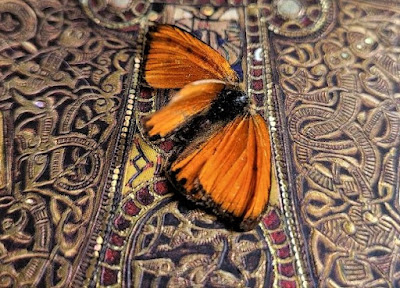Far from the beach, but still surrounded by treasure of all kinds just ready to be found, looked at, gloated over, gleaned and swiped or simply created! Here are my latest finds....
Saturday, April 29, 2023
The Enduring Beauty of the Butterfly...
As Spring wakes up, it is magical to watch the different forms of life likewise emerging and to think about those which will
soon make their appearance, however fleeting, as the months go by. One of the most magical of these has to be the humble butterfly.'Humble', as they once seemed such a familiar sight, yet these modest, little creatures of great beauty now appear to be getting rarer and their delicate presence can no longer be taken for granted as a staple of the sunnier months of the year. All these specimens here below are precious finds - found dead, I should add - that date back years and decades even. Although some of these - the Red Admiral, Peacock and Tortoiseshell - are still to be found in the wild, I wonder if they are commonplace today?
Clouds of butterflies fluttering around flowering plants and bushes were truly mesmerizing in my childhood but now I have to content myself with my old, tattered collection! Some of my butterflies are now over forty years old, but the magic endures. How can Nature be so perfect? Of course such perfection and the magical metamorphosis that leads to the emergence of such beauty have always fascinated Man and given rise to mythological and spiritual beliefs that have intertwined in such a manner that even pure logic and the rationality of science cannot dismiss. Even today, many people believe that the butterfly has some rather 'other-wordly' significance to the extent that a specimen that suddenly wakes up in Winter must surely represent someone or something 'other'...
In fact, the full life cycle of the butterfly, from the order of Lepidoptera (from the Greek 'scaly wings') is seen to reflect Man's transformation from earthly to spiritual Life itself, commencing with the caterpillar that symbolizes the ties of our physical needs. Following this comes the seemingly lifeless chrysalis phase, referred to by the Ancient Greeks as nekydallon, meaning 'the shell of the dead'. Indeed, the creature lies dormant in this sarcophagus which will finally split open to reveal the fully-formed adult within; a butterfly ready to unfurl its wings and fly free of all the physical binds of life. Again, this transformative stage is drawn upon in Buddhist belief; 'What the caterpillar perceives to be the end, to the butterfly is just the beginning'.
Set free from an earth-bound existence and mortal death, the body breaks away and upwards, soaring to the heavens. Not surprisingly, the word for butterfly and soul in classical Greek is psyche; the soul of the dead. Anima is the Latin word for 'soul' and 'breath', with the air-borne butterfly coming to symbolize the soul’s exit from the body.
The ancient myth of Psyche and Eros signifies the soul, the butterfly and divine love that must endure the hardest tests before attaining unity and immortality. It is based on the fable of the Latin prose writer Apuleius, from The Metamorphoses and tells of the trials and tribulations that this beautiful young mortal girl must undergo in order to be with her beloved Eros. Having drawn the ire of the Goddess of Beauty, Psyche is set on a long, convoluted journey that is both hindered and helped by various different gods - Aphrodite, Apollo, Zeus, Zyphyr, Persephone and Hermes being just a few who figure in this meandering tale...
Punished for her beauty by the jealous Aphrodite, Psyche is sent on a mission to the dark abyss of the Underworld before falling into a state of permanent sleep until she is eventually brought to life again by one of Eros' arrows. Finally given ambrosia, Psyche is granted immortality as winged goddess of the soul and from her union with Eros was born Hedone, the goddess of pleasure. Strangely enough, I don't think I was even familiar with this particular myth, and yet it was a source of inspiration for much later works of literature and flights of fancy such as the fairy tale of Beauty and the Beast and likewise Shakespeare's A Midsummer Night's Dream.
Subscribe to:
Post Comments (Atom)







No comments:
Post a Comment
Leave a message - please share your ideas!